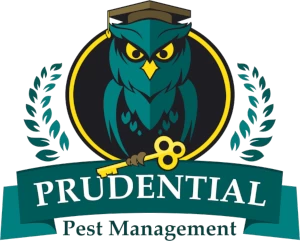Bees, Wasps, & Yellow Jackets
We Control Bees, Wasps, & Yellow Jackets
Our treatments eliminate bees, wasps, yellow jackets, hornets, and other insects. We’ll help you enjoy your patios, pools, and yards again—our $169 single treatment price guarantees to solve your problem with those stinging insects. Our Silver Package can save money and keep you safe for the entire season!
Are They in Your Walls?
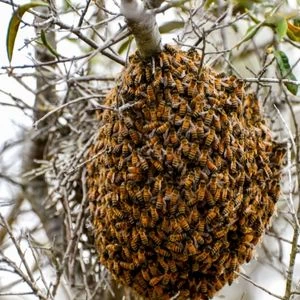 Honey bees rarely nest in homes. 99% of the time, Yellow Jackets nest in your walls, eves, bricks, siding, or the ground. Yellow jackets can easily be controlled without putting holes in the wall or tearing down drywall or siding. Our silver package provides treatments that will deter them from nesting in the first place.
Honey bees rarely nest in homes. 99% of the time, Yellow Jackets nest in your walls, eves, bricks, siding, or the ground. Yellow jackets can easily be controlled without putting holes in the wall or tearing down drywall or siding. Our silver package provides treatments that will deter them from nesting in the first place.
It is essential to be cautious around all stinging insects, predominantly yellow jackets. They can sting multiple times and are very protective of their nesting area. The key to controlling these pests is to treat them early in the spring and summer. If you wait until late Fall when the temperatures drop, control may take weeks. The cold weather also pushes them further into the home, causing them to enter your living space.
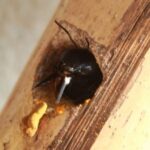 Carpenter bees look like Bumble bees but lack the hair on the backside. Instead, they have shiny black bodies. Carpenter bees bore perfectly round holes into wood timbers, decks, railings, fascia boards, etc. Then, they make a 90-degree turn tunnel, which increases in length yearly, weakening the structure. Carpenter bees are not covered under a general stinging insect treatment because they require different methods to control.
Carpenter bees look like Bumble bees but lack the hair on the backside. Instead, they have shiny black bodies. Carpenter bees bore perfectly round holes into wood timbers, decks, railings, fascia boards, etc. Then, they make a 90-degree turn tunnel, which increases in length yearly, weakening the structure. Carpenter bees are not covered under a general stinging insect treatment because they require different methods to control.
We control Carpenter bees for a one-time treatment of $169 and recommend our silver package to maintain control throughout the summer.
More Bees, Wasps, Yellow Jackets, & Hornets
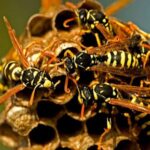 Bumble bees occasionally build a nest in your home, usually in cardboard, insulation, or other soft materials. They can easily be controlled with our single insect treatment.
Bumble bees occasionally build a nest in your home, usually in cardboard, insulation, or other soft materials. They can easily be controlled with our single insect treatment.
Paper Wasps can usually be found in exposed nests under eves, window frames, deck railings, and behind window shutters. The orange antenna can identify paper wasps. (Yellowjackets have black antennas). Paper wasps are not as aggressive as yellow jackets but will not hesitate to protect their nest. A single spring treatment can easily control paper wasps.
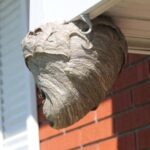 Bald Faced Hornets make large rounded nests, usually under eves, decks, or trees and bushes. These hornets may seem mild until you disturb the nest. They will attack you with full force. A Bald-faced hornet’s sting is one of the most painfully stinging insects.
Bald Faced Hornets make large rounded nests, usually under eves, decks, or trees and bushes. These hornets may seem mild until you disturb the nest. They will attack you with full force. A Bald-faced hornet’s sting is one of the most painfully stinging insects.
These nests often go unnoticed until Fall after the leaves drops from the trees. Treatments in the Fall are usually not needed because the nest will be inactive. The workers die in the Fall, and the queens will go elsewhere to overwinter. A single treatment will take care of the bald face hornet colony.
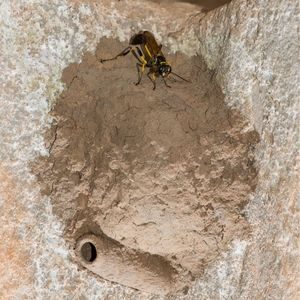 Mason Wasps are not aggressive and are often found in holes in bricks or other access points in masonry products. Mason wasps are also nesting in the hollow ends of bamboo blinds. A single exterior treatment is needed to control these tiny insects.
Mason Wasps are not aggressive and are often found in holes in bricks or other access points in masonry products. Mason wasps are also nesting in the hollow ends of bamboo blinds. A single exterior treatment is needed to control these tiny insects.
Mud Dauber’s nests are usually seen on the walls of a home as exposed tubes of mud. Mud Daubers are nonaggressive and help control other insects. It is essential to scrape the mud tubes off the building because the presence of one nest will attract others. A single exterior treatment is all that is needed to control them.
Honey Bees are rarely an issue in homes. We will contact a beekeeper to remove the honey bees when possible. If the honey bees pose a risk to your students, family, or staff, we can take immediate action. Sometimes honey bees will swarm. You can find thousands on a wall or other structures overnight, but there’s no need to be alarmed. They will usually move on within a few hours.
Product Safety
It is always possible to hurt non-target species, but honey bees typically forage flowers and rarely nest in homes. When we pray, we target areas where wasps and hornets frequent; we try to avoid spraying flowers. We have had customers with honey bee colonies in the backyard that remained unaffected by our treatments on the home, but there is always a risk.
Prudential Pest Management services the following areas in Michigan:
Genesee County, Tuscola County, Lapeer County, Oakland County, Livingston County, Shiawassee County, Saginaw County, Burton, Clio, Davison, Fenton, Flint, Flushing, Grand Blanc, Linden, Montrose, Mount Morris, Swartz Creek, Gaines, Goodrich, Lennon, Montrose, Otisville, Otter Lake, Clayton Township, Fenton Township, Flint Township, Flushing Township, Genesee Township, Grand Blanc Township, Montrose Township, Mount Morris Township, Mundy Township, Vienna Township, Argentine Township, Atlas Township, Davison Township, Gaines Township, Richfield Township, Thetford Township, and Forest Township. We service all communities in Genesse and its surrounding counties.
